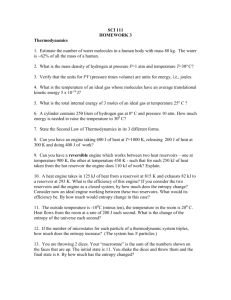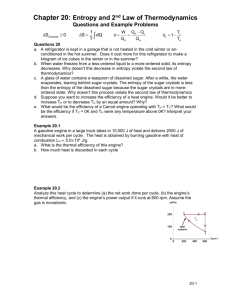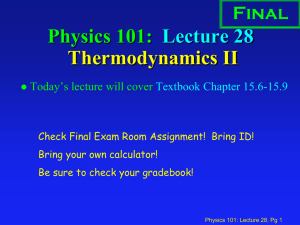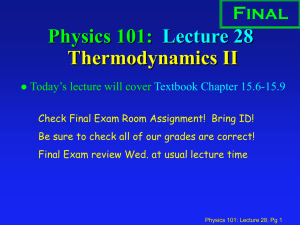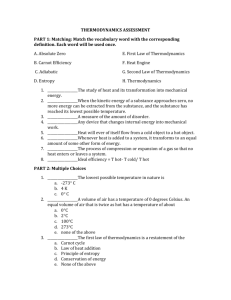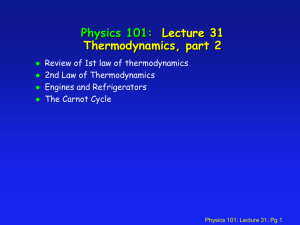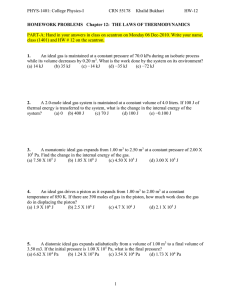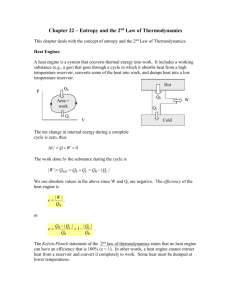Physics 101: Lecture 28 Thermodynamics II
advertisement
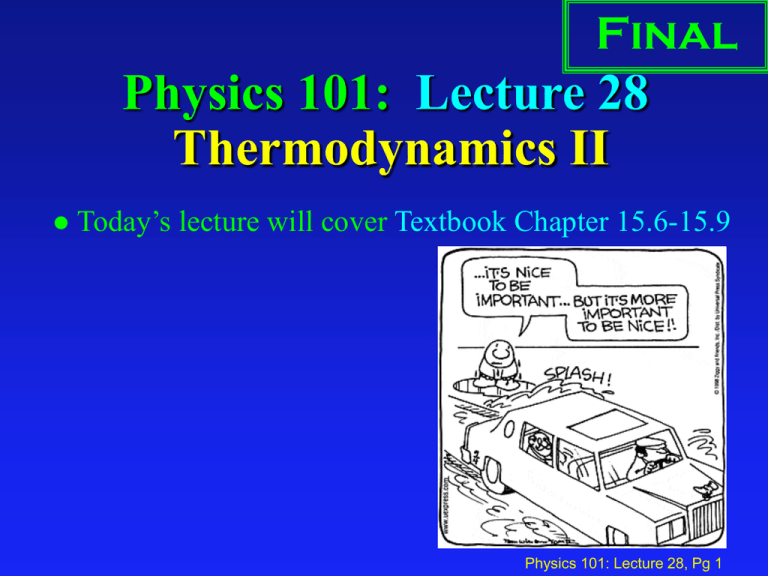
Final Physics 101: Lecture 28 Thermodynamics II Today’s lecture will cover Textbook Chapter 15.6-15.9 Physics 101: Lecture 28, Pg 1 Recap: 1st Law of Thermodynamics energy conservation Q = DU + W Work done by system Increase in internal energy of system Heat flow into system U depends only on T (U = 3nRT/2 = 3pV/2) point on p-V plot completely specifies state of system (pV = nRT) work done is area under curve for complete cycle P V DU=0 Q=W Physics 101: Lecture 28, Pg 2 Engines and Refrigerators HEAT ENGINE REFRIGERATOR TH TH QH system QH W QC TC W QC TC system taken in closed cycle DUsystem = 0 therefore, net heat absorbed = work done QH - QC = W (engine) QC - QH = -W (refrigerator) energy into green blob = energy leaving green blob Physics 101: Lecture 28, Pg 3 Heat Engine: Efficiency The objective: turn heat from hot reservoir into work The cost: “waste heat” 1st Law: QH -QC = W HEAT ENGINE TH QH efficiency e W/QH = W QC TC Physics 101: Lecture 28, Pg 4 Heat Engine ACT Can you get “work” out of a heat engine, if the hottest thing you have is at room temperature? HEAT ENGINE TH 300K A) Yes B) No QH W QC TC = 77K Physics 101: Lecture 28, Pg 5 Refrigerator: Coefficient of Performance REFRIGERATOR The objective: remove heat from cold reservoir The cost: work TH QH 1st Law: QH = W + QC coeff of performance Kr QC/W = QC/W = W QC TC Physics 101: Lecture 28, Pg 6 New concept: Entropy (S) A measure of “disorder” A property of a system (just like p, V, T, U) related to number of number of different “states” of system Examples of increasing entropy: ice cube melts gases expand into vacuum Change in entropy: DS = Q/T » >0 if heat flows into system (Q>0) » <0 if heat flows out of system (Q<0) Physics 101: Lecture 28, Pg 7 ACT A hot (98 C) slab of metal is placed in a cool (5C) bucket of water. DS = Q/T What happens to the entropy of the metal? A) Increase B) Same C) Decreases What happens to the entropy of the water? A) Increase B) Same C) Decreases What happens to the total entropy (water+metal)? A) Increase B) Same C) Decreases Physics 101: Lecture 28, Pg 8 Second Law of Thermodynamics The entropy change (Q/T) of the system+environment 0 never < 0 order to disorder Consequences A “disordered” state cannot spontaneously transform into an “ordered” state No engine operating between two reservoirs can be more efficient than one that produces 0 change in entropy. This is called a “Carnot engine” Physics 101: Lecture 28, Pg 9 Carnot Cycle Idealized Heat Engine No Friction DS = Q/T = 0 Reversible Process » Isothermal Expansion » Adiabatic Expansion » Isothermal Compression » Adiabatic Compression Physics 101: Lecture 28, Pg 10 Engines and the 2nd Law The objective: turn heat from hot reservoir into work The cost: “waste heat” HEAT ENGINE TH QH 1st Law: QH -QC = W efficiency e W/QH =W/QH = 1-QC/QH W QC TC Physics 101: Lecture 28, Pg 11 Example Consider a hypothetical refrigerator that takes 1000 J of heat from a cold reservoir at 100K and ejects 1200 J of heat to a hot reservoir at 300K. 1. How much work does the refrigerator do? 2. What happens to the entropy of the universe? 3. Does this violate the 2nd law of thermodynamics? TH QH W QC TC Physics 101: Lecture 28, Pg 12 Preflight Consider a hypothetical device that takes 1000 J of heat from a hot reservoir at 300K, ejects 200 J of heat to a cold reservoir at 100K, and produces 800 J of work. Does this device violate the second law of thermodynamics ? 1. Yes 2. No Physics 101: Lecture 28, Pg 13 Act Which of the following is forbidden by the second law of thermodynamics? 1. Heat flows into a gas and the temperature falls 2. The temperature of a gas rises without any heat flowing into it 3. Heat flows spontaneously from a cold to a hot reservoir 4. All of the above Physics 101: Lecture 28, Pg 14 Summary First Law of thermodynamics: Energy Conservation Q = DU + W Heat Engines Efficiency = = 1-QC/QH Refrigerators Coefficient of Performance = QC/(QH - QC) Entropy DS = Q/T 2nd Law: Entropy always increases! Carnot Cycle: Reversible, Maximum Efficiency e = 1 – Tc/Th Ch 15 Problems 1, 5, 9, 11, 15, 21, 31,41 Physics 101: Lecture 28, Pg 15


